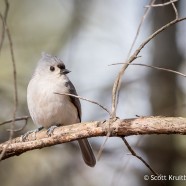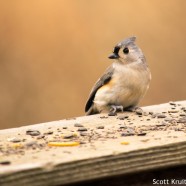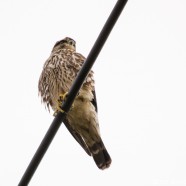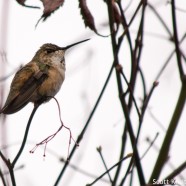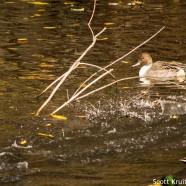Tufted Titmouse
This cute Tufted Titmouse may be building a home soon, if it is not already, depending on where you live. Have you ever put out dog fur for them to use as nesting material? Titmice, and other small songbirds that use nestboxes and cavities like the Black-capped Chickadee, will take fur that you put out in say, an empty suet cage, and use it to line their nest. Some have even been known to try to pull the fur right off a dog or another animal! You may want to be sure, of course, that the fur is free of any parasites or chemicals and is otherwise clean. They will readily pull out very large...
Read MoreHead-turning Tufted Titmouse
This Tufted Titmouse (Baeolophus bicolor) is a real head-turner! Yes, I will be here all week, every week…but did you know these gals and guys are still expanding their range northward? Back in my grandfather’s (and Roger Tory Peterson’s) day in they were very rare in New York and New England. In the middle of the last century they started a massive surge to the north likely thanks to climate change, the spread of feeding stations, and changing habitats as the suburban and developed landscape opened up for their arrival. Scott Kruitbosch Conservation & Outreach...
Read MoreMerlin on Wire
Merlins certainly do love their power lines! Perhaps next spring and summer you will find one like this in your neighborhood with a nest not far away. We are seeing more and more of them locally in the Chautauqua-Allegheny region. During the last breeding season we had a pair less than a mile away from us at the Roger Tory Peterson Institute of Natural History in Jamestown, New York. They can be found even in suburban to near urban habitats.
Read MoreRufous Hummingbird and vagrancy
This past weekend I was able to briefly visit and photograph a vagrant hummingbird from the west at an undisclosed location in Connecticut. I was told of the sighting by two experts who had documented the bird a couple hours earlier, confirming via observations and photos that this was a Rufous Hummingbird (Selasphorus rufus), and not the very easy to confuse Allen’s Hummingbird (Selasphorus sasin) which would have been even more rare. The bird pictured below is an immature female. She paused only briefly in the tree being otherwise occupied and somewhat anxious, zipping back and...
Read MoreNorthern Pintails: male and female
As we get deeper into autumn we also receive a greater diversity of waterfowl joining us in the Northeast. I wanted to share some photos of male and female Northern Pintails (Anas acuta) that I took last week in the middle of a large flock of Mallard and American Black Duck. Some of them were more interested in mating than anything else making it difficult for the Pintails trying to feed, preen and stretch. I noticed the male first due to its distinctive plumage that always helps it stands out well in a crowd. Northern Pintails are slender birds and males have a long, pointed tail that help...
Read More



